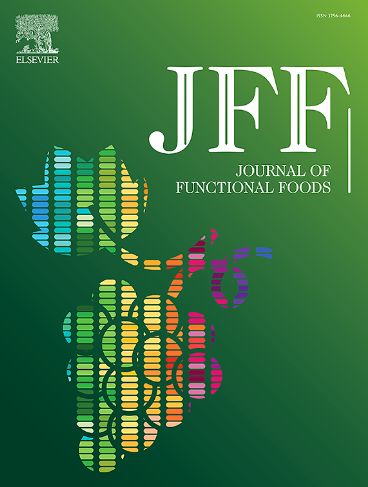山楂多糖对非酒精性脂肪肝的作用及机制研究
IF 3.8
2区 农林科学
Q2 FOOD SCIENCE & TECHNOLOGY
引用次数: 0
摘要
山楂是山楂的干果。以水为流动相洗脱的山楂多糖(CPPs- h -1)是山楂提取物的重要活性成分之一。CPPs-H-1具有体外抗氧化和调节血脂的活性。因此,我们研究了CPPs-H-1对C57/BL6J小鼠非酒精性脂肪性肝病(NAFLD)的影响。由此可见,CPPs-H-1抑制了大鼠体重的快速增长,减轻了高脂饮食引起的肝损伤,显著降低模型组大鼠肝脏指数和血脂水平,抑制炎症和细胞因子的产生,抑制氧化应激。CPPs-H-1还能增强肠道屏障功能。在门水平上,CPPs-H-1降低厚壁菌门与拟杆菌门之比(F/B),调节短链脂肪酸(SCFAs)含量。CPPs-H-1可能调节肠道菌群组成,改善肠道屏障功能,最终延缓小鼠NAFLD的进展。此外,CPPs-H-1通过增强amp活化蛋白激酶(AMPK)/过氧化物酶体增殖物活化受体α (PPARα)信号通路促进脂肪酸氧化,从而改善NAFLD的进展。这些结果证实了CPPs-H-1在NAFLD的改善中具有多途径、多靶点的作用。本文章由计算机程序翻译,如有差异,请以英文原文为准。

Effect and mechanism of polysaccharide from Crataegus pinnatifida on nonalcoholic fatty liver disease
Crataegus pinnatifida is the dried fruit of Crataegus pinnatifida. Crataegus pinnatifida polysaccharides (CPPs) eluted with water as the mobile phase (CPPs-H-1) is one of the important active components. CPPs-H-1 has anti-oxidation and blood lipid regulation activities in vitro. Therefore, we investigated the effects of CPPs-H-1 on nonalcoholic fatty liver disease (NAFLD) in C57/BL6J mice. As a result, CPPs-H-1 inhibited the rapid growth of body weight and alleviated the liver injury caused by high-fat diets, significantly reducing the liver index and blood lipid levels in the model group, inhibiting the production of inflammation and cytokines, and inhibiting oxidative stress. CPPs-H-1 also enhanced intestinal barrier function. At the phylum level, CPPs-H-1 reduced the ratio of Firmicutes to Bacteroides (F/B) and regulated the content of short-chain fatty acids (SCFAs). The CPPs-H-1 may regulate intestinal flora composition, and improve intestinal barrier function, ultimately delaying the progression of NAFLD in mice. Also, CPPs-H-1 improved NAFLD progression by enhancing the Amp-activated protein kinase (AMPK)/peroxisome proliferator-activated receptor α (PPARα) signaling pathway to enhance fatty acid oxidation. All these results confirm that CPPs-H-1 plays a multi-pathway and multi-target role in the improvement of NAFLD.
求助全文
通过发布文献求助,成功后即可免费获取论文全文。
去求助
来源期刊

Journal of Functional Foods
FOOD SCIENCE & TECHNOLOGY-
CiteScore
9.60
自引率
1.80%
发文量
428
审稿时长
76 days
期刊介绍:
Journal of Functional Foods continues with the same aims and scope, editorial team, submission system and rigorous peer review. We give authors the possibility to publish their top-quality papers in a well-established leading journal in the food and nutrition fields. The Journal will keep its rigorous criteria to screen high impact research addressing relevant scientific topics and performed by sound methodologies.
The Journal of Functional Foods aims to bring together the results of fundamental and applied research into healthy foods and biologically active food ingredients.
The Journal is centered in the specific area at the boundaries among food technology, nutrition and health welcoming papers having a good interdisciplinary approach. The Journal will cover the fields of plant bioactives; dietary fibre, probiotics; functional lipids; bioactive peptides; vitamins, minerals and botanicals and other dietary supplements. Nutritional and technological aspects related to the development of functional foods and beverages are of core interest to the journal. Experimental works dealing with food digestion, bioavailability of food bioactives and on the mechanisms by which foods and their components are able to modulate physiological parameters connected with disease prevention are of particular interest as well as those dealing with personalized nutrition and nutritional needs in pathological subjects.
 求助内容:
求助内容: 应助结果提醒方式:
应助结果提醒方式:


